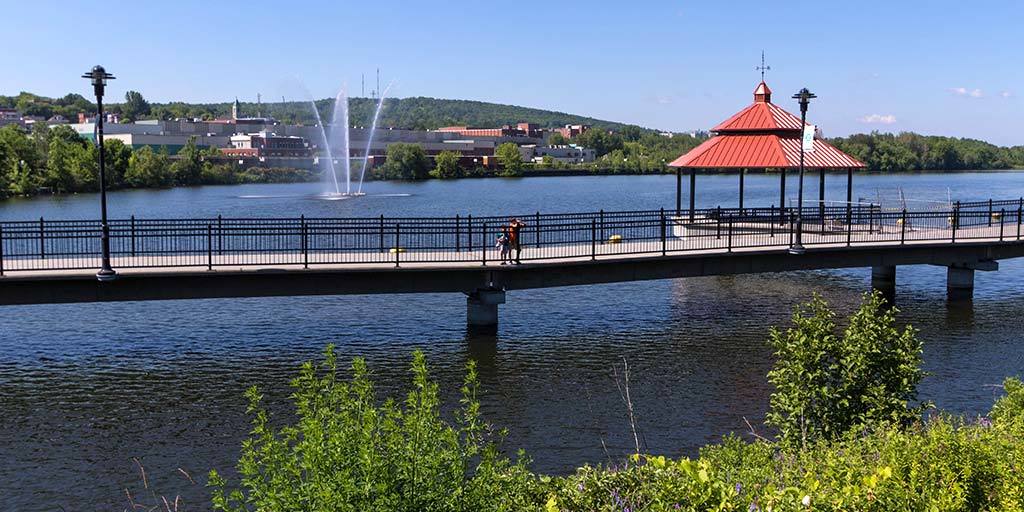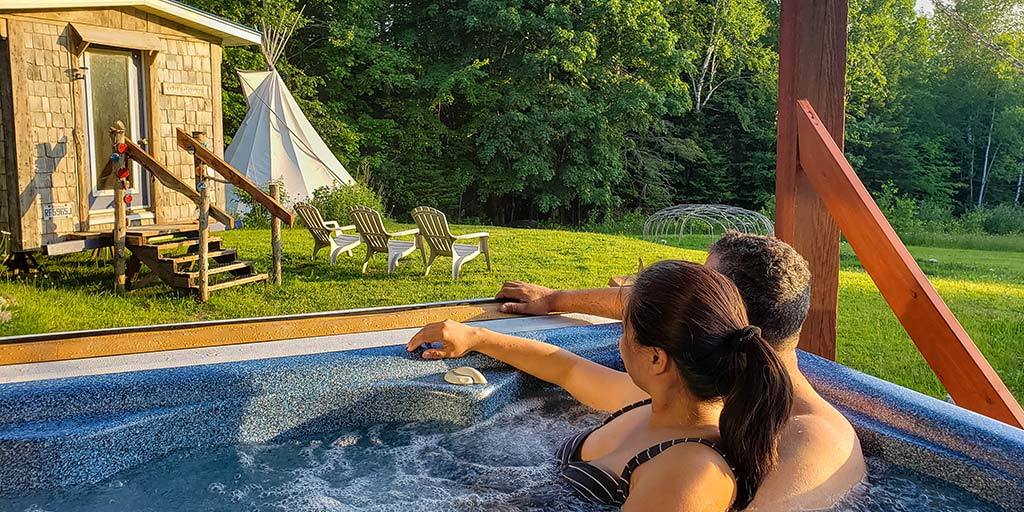Discover the wonders of Parc national du Mont-Mégantic, Quebec’s premier Dark Sky Reserve. Our comprehensive guide to Mont-Megantic National Park covers everything from hiking its stunning peaks to stargazing at the renowned ASTROLab, ensuring you make the most of your adventure.
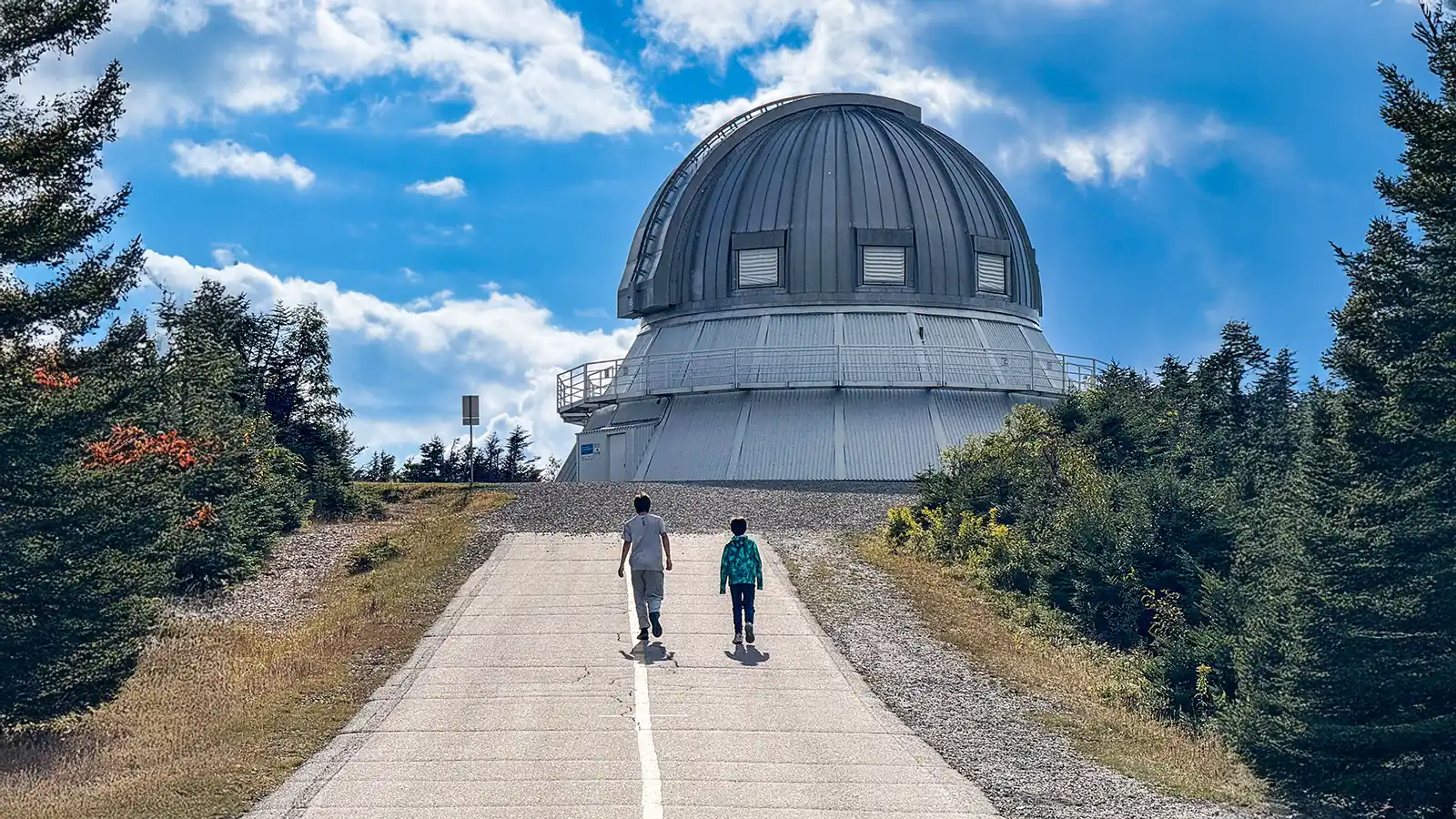
When I first visited Parc National Mont-Mégantic during my Indigenous-themed road trip through Quebec a few years ago, I was floored. This Quebec provincial park is gorgeous on so many levels. The landscapes are dramatic, the hiking is adventurous and varied, and its location as one of Quebec’s most important dark sky preserves is made even more special by the presence of one of Canada’s most important observatories.
Dark skies, some of the darkest in Canada, stretch across the northern Appalachian mountains where Mont-Mégantic lies. It’s these skies that draw thousands of astronomers, astro-photographers, and scientists to the summits within the park. And families, well, they can take part in this science bonanza as well through visits to the observatory and to the on-site science museum, Astrolab.
Mont-Mégantic is so much more than your typical provincial park. And in this guide to hiking, camping, and exploring Mont-Mégantic National Park, I’m sharing everything that you need to know to visit and experience the best trails, camping, and wonders of the park.
About Parc National Mont-Mégantic

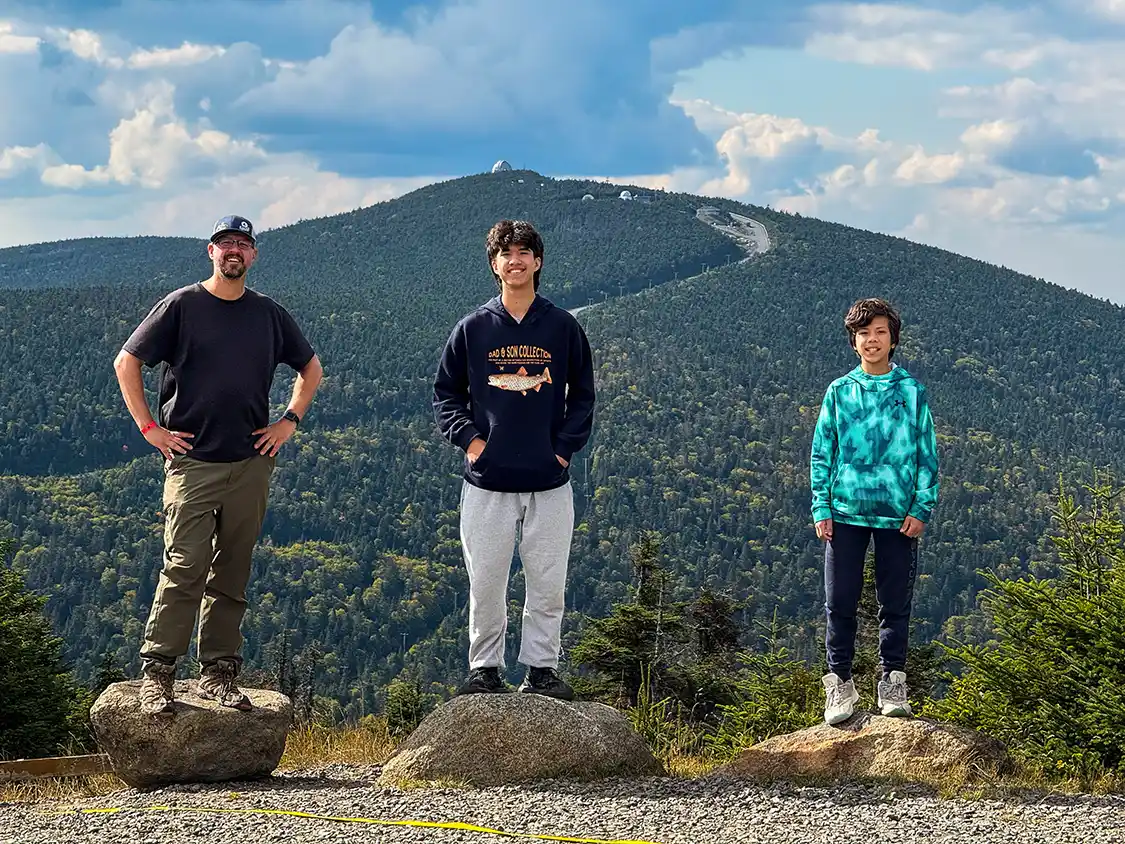
My boys and I recently returned to Mont-Mégantic NP on Dylan’s birthday, embarking on a road trip through Quebec’s Eastern Townships. We spent a long weekend touring through one of our favorite regions of the province, stopping in the towns of Bromont, Coaticook, and the largest city in the Eastern Townships, Sherbrooke, and camping under the stars in Mont-Mégantic and Parc de la Gorge Coaticook.
The whole trip was amazing. Grabbing lunch at local fromageries, taking in the gorgeous nighttime lightshows at Coaticook Gorge, and, of course, taking every moment I could to taste the delicious local brews along the Eastern Townships’ craft beer trail.
But the highlight of our trip was Parc National Mont-Mégantic. Two days of hiking, science exhibits, and camping at one of my favorite provincial parks in Quebec.
Located on the northern edge of the Appalachian Mountains, about 30 minutes from the town of Lac Megantic, and 20 minutes from the scenic town of Piopolis, Parc National du Mont-Mégantic blends unique landscapes with astronomical wonders.
The park was established in 1994 to protect its famous dark skies from light pollution. It went on to become the world’s very first International Dark Sky Preserve. Its status as a provincial park enabled SEPAQ (the organization in charge of Quebec’s provincial parks) to provide easier access to its rugged landscapes.
Parc National Mont-Mégantic is divided into two large sectors: Franceville and Observatoire. The park is a year-round destination offering everything from challenging hikes to rustic camping and cozy cabins, all while offering some of the most dramatic skies in the world, clear from the intrusion of city lights.
Check Out Our Video On Our Fall Road Trip To Mont-Megantic and Quebec’s Eastern Townships
If you are interested in traveling to Mont-Megantic National Park, check out this video about our fall road trip through the Eastern Townships to Mont-Megantic. Along the way, we hit up the towns of Bromont. Sherbrooke, and Coaticook, visiting fromageries, Eastern Townships microbreweries, and incredible cultural and food experiences.
Camping and Accommodations at Mont Megantic National Park
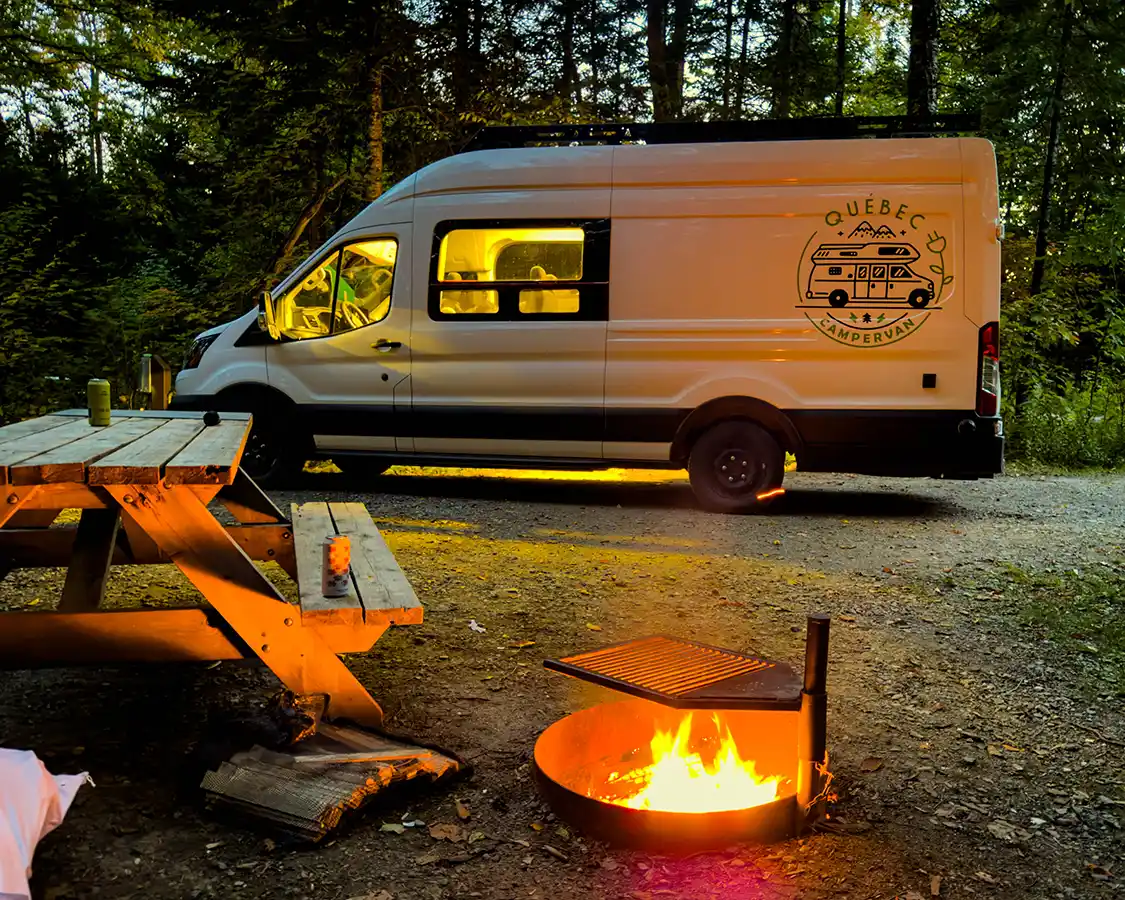
On my family’s first visit to Mont Megantic National Park, we didn’t get the opportunity to camp. We were staying at a beautiful Wendat-run glamping property in Piopolis, so our stop in the park was just for a day. This time, though, the boys and I had the chance to explore both the Observatoire sector and camp in the Franceville sector.
What we found is that Parc National du Mont-Mégantic has a wide range of accommodation types that offer great options for every type of visitor. There are rustic back-country campsites for seasoned backpackers and cabins perfect for families seeking comfort. The options are divided between the front-country Franceville sector, accessible by car, and the more rustic backcountry Observatoire sector.
We were living it up in an all-electric campervan that we had picked up from Bromont Campervans a couple of days before, so we had everything that we needed and a full charge thanks to our electrical site at the Franceville campground.
Here’s a breakdown of the camping and accommodation options at Mont Megantic National Park
Front-Country Camping (Franceville Sector)
Most of the campsites in Parc National Mont-Mégantic are located in the Franceville sector, which is about a 20-minute drive from the park’s main visitor center in the Observatoire sector. Here you’ll find a range of rustic campsites, raised platform camping, and SEPAQ’s comfortable “pret-a-camper,” or “ready-to-camp” sites like the one that we enjoyed while camping in Parc National d’Opemican on Lake Temiskaming.
The Franceville sector has 68 campsites, including:
- Thirty-three sites semi-serviced campsites that have access to water nearby, but not necessarily in within the campsite.
- Thirty-five serviced campsites (water and electricity), making them ideal for RVs and trailers. This is what we used for our electric campervan.
- Eight Ready-to-Camp Tents: These “glamping” sites are perfect for those who want the camping experience without the hassle of setting up and hauling too much gear. These canvas tents are spacious and equipped with electric heating, beds, and everything you need for food preparation, including a small fridge and a propane camp stove, and even dishes. These are a popular option for a stress-free escape, but they also book up the quickest.
Backcountry Camping (Observatoire Sector)
To really dive into the experience of Parc National Mont-Mégantic, you’ll want to get out onto the trails. The Observatoire sector has a wealth of backcountry camping sites that are only available by hiking.
- Rustic Tent Platforms: The Grande-Ourse campground is located a 2.2 km hike from the visitor center. This backcountry campground features thirteen rustic raised tent platforms. These are tent-only sites where you can pitch your tent on a level wooden platform. These sites offer a more intimate connection with nature. Winter camping at Mont-Megantic National Park is also available here on snow-covered platforms for a unique cold-weather experience.
Unique Accommodations at Parc National Mont-Mégantic
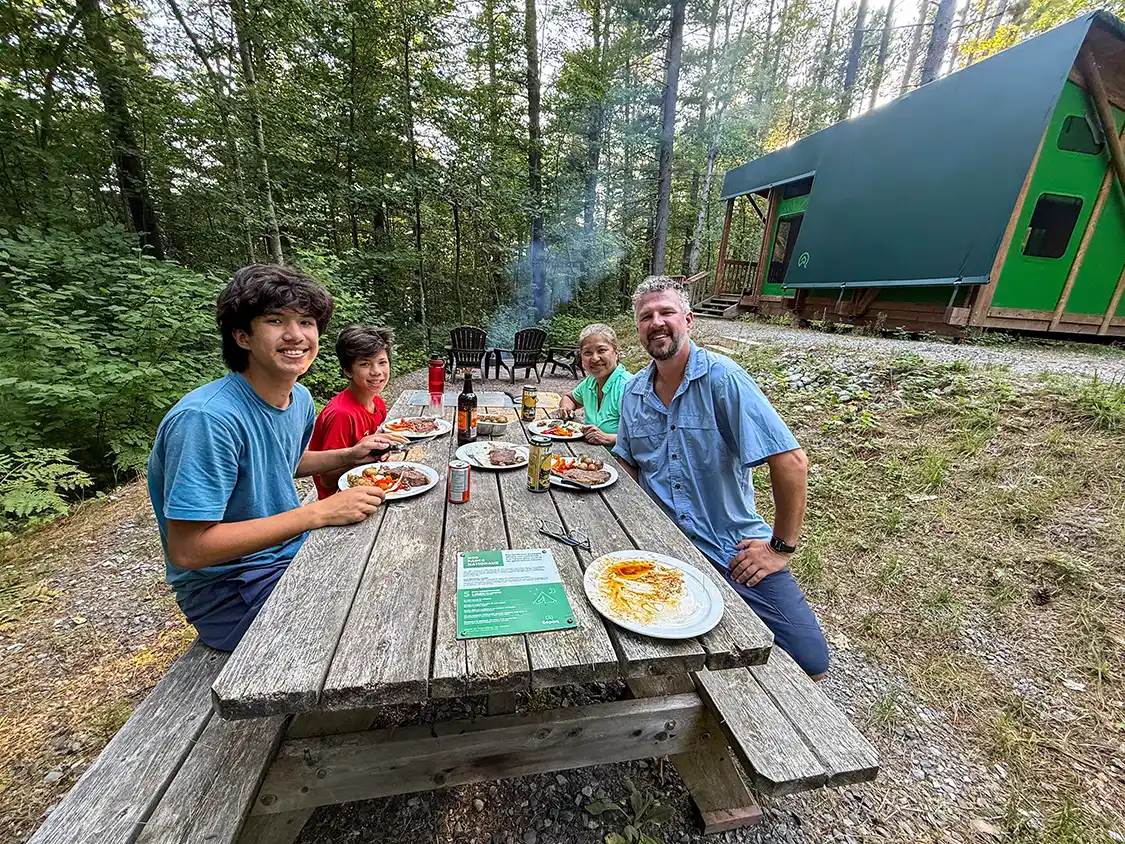
Beyond traditional camping, Mont-Megantic National Park offers unique accommodations perfect for year-round stays.
- Rustic Shelters: These shelters are located along hiking trails in both sectors and are a great option for multi-day treks. They are equipped with a wood stove, beds, and a table, but require you to bring your own cooking and lighting supplies.
- EXP. and Écho Cabins: These cabins offer an elevated and immersive experience. The Chalet EXP. is a modern, compact cabin with large windows designed to make you feel like you are still in the forest. The Chalet Écho is a slightly larger, family-friendly option. Both cabins come fully equipped with kitchens, bathrooms, and a wood stove, providing a comfortable and cozy retreat after a day of exploring. These are an excellent choice for a trip focused on stargazing, as they offer the warmth and comfort of a cottage while being in the heart of this dark sky preserve.
Things to Do at Parc National du Mont-Mégantic: An Activities Guide
Parc National du Mont-Mégantic is a wonder to explore. My boys and I spent two days hiking and exploring the museums and the most exciting things to do in the park. The park is a four-season destination. In my opinion, autumn is the best time to visit. Less bugs, amazing weather, and those gorgeous fall colors. But really, any season offers an amazing experience.
If you’re looking for ways to spend your time in Mont-Megantic, here is a guide to the top things to do in the park.
Mont-Megantic Hiking Trails
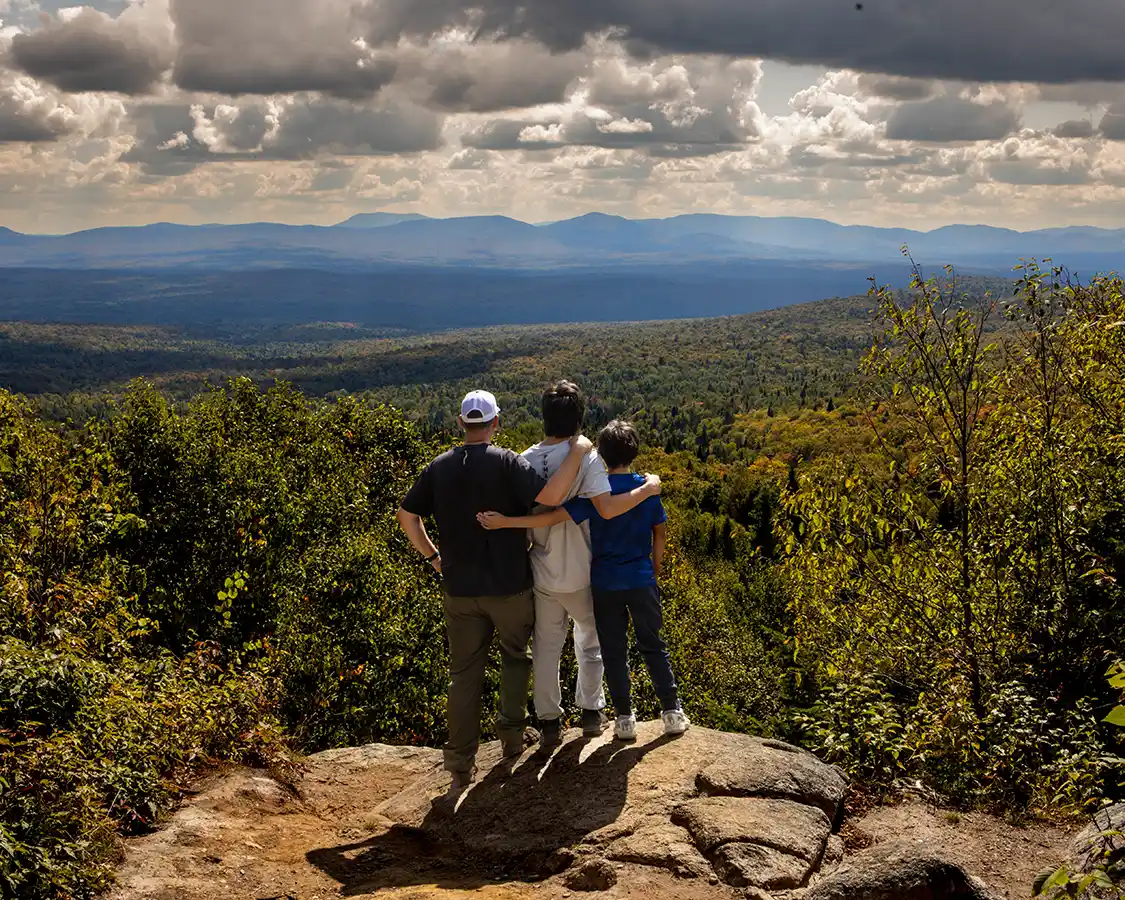
Mont-Megantic National Park has an extensive network of over 60 kilometers of hiking trails. Many of these bring hikers to some of the park’s most epic viewpoints. Some of my favorites were the Parcours du Soleil hike, a moderate 3.2 km hike with a brilliant rocky peak on the edge of the forest, and Mont-Saint-Joseph, a 9.4 km loop offering amazing views of the observatory and the surrounding landscape.
There are hikes for every skill level, and each of the sectors offers something unique.
- Hikes in the Observatoire Sector: The Observatoire sector houses Mont-Megantic National Park’s most dramatic and challenging hiking trails. Those who take on the challenge are rewarded with mountainous terrain and rewarding views. Popular hikes include the Sentier des Crêtes, a 1 km trail with panoramic lookouts, and the challenging Trois-Sommets Trail, a 15 km loop that takes you to the park’s three different peaks. The Mont-Mégantic and Mont-Saint-Joseph loops are also must-dos for their scenic beauty and views of the surrounding region.
- Franceville Sector: The Franceville sector is much quieter than the Observatoire sector. This sector is ideal for families and those seeking a more relaxed hiking experience. The hiking trails in Franceville are less strenuous and flatter than those in the rest of the park. The Sentier des Escarpements is a popular choice, known for its small waterfalls and impressive rock formations. The Promenade du Ruisseau loop is a short, easy trail perfect for a leisurely stroll.
Visit the Observatory and ASTROLab

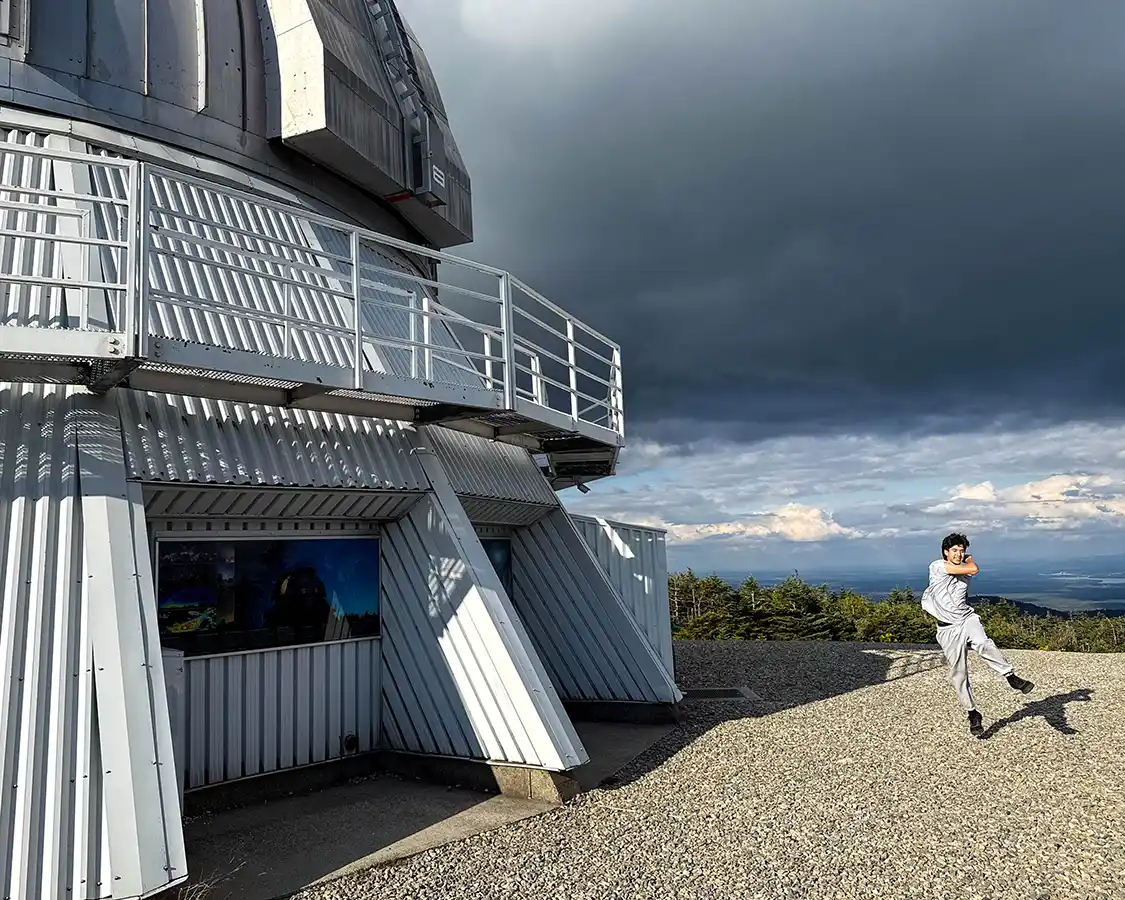
At the heart of Mont-Megantic National Park’s mission is its designation as a Dark Sky Reserve. The core of that mission is its world-class astronomical facilities, which are open to the public.
- ASTROLab: This was one of our favorite parts of the park. My family has visited the Mont-Megantic Astrolab twice, and both times have been awesome. The ASTROLab is a modern science activity center focused on taking visitors on a cosmic journey. The Mont-Megantic ASTROLab has several exhibits, including a wild VR experience that had us zipping through the solar system between planets, moons, and stars. This space science museum also has engaging multimedia experiences and interactive exhibits that explain astronomical phenomena. It is the starting point for guided tours and evening programs that take you up to the observatory.
- Mont-Mégantic Astronomical Observatory: Perched atop Mont-Mégantic, this is Canada’s most powerful astronomical observatory. While primarily a research facility, it opens its doors to the public for special events. On our first visit a few years ago, we had the chance to pop in and get an in-person glimpse at the observatory. We even got to see Saturn and Jupiter through the observatory’s massive telescope. There are programs that allow visitors to take part in evening stargazing activities, with opportunities to look through telescopes and learn about ongoing research.
Experience the Mont-Megantic Dark Sky Reserve
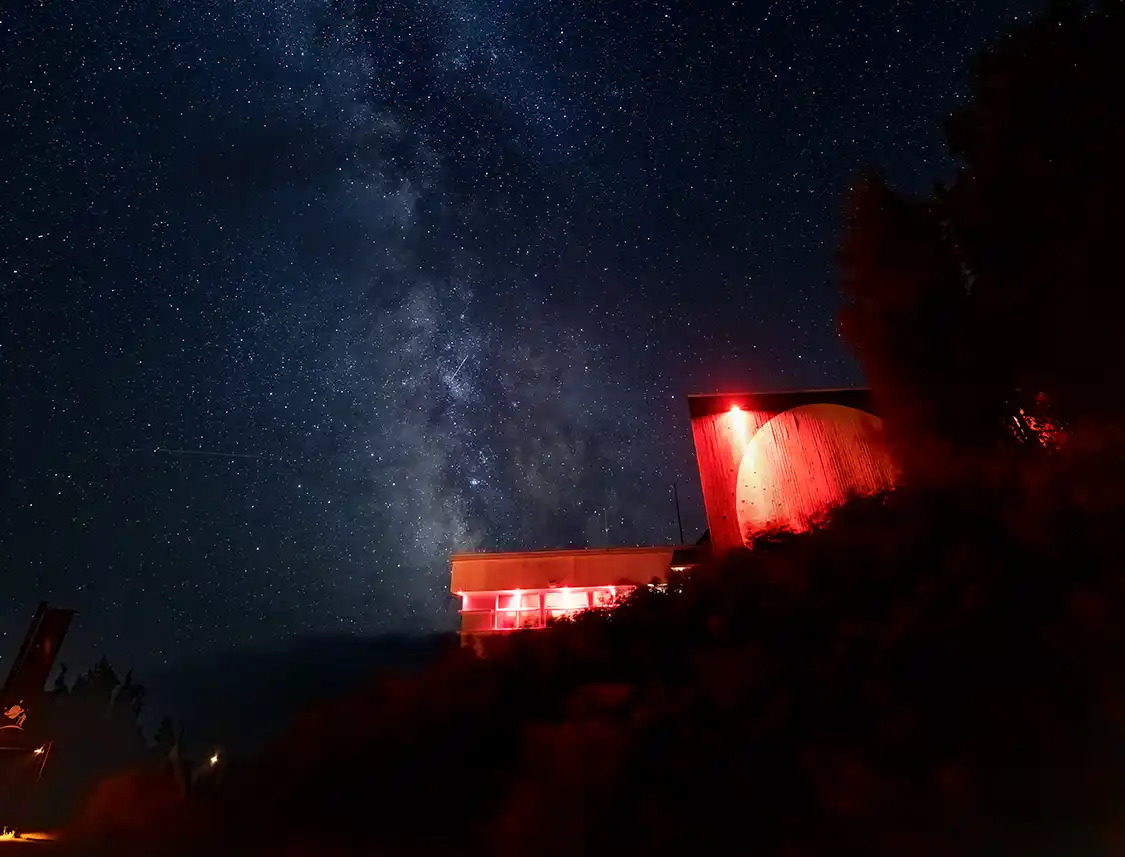
Mont-Megantic National Park offers an amazing range of unique experiences designed to take full advantage of its pristine night skies. And those experiences are expanding thanks to a massive new development at the summit of Mont-Megantic near the Observatory. This new development, set to launch in the spring of 2026, includes a large platform for night sky programming, a multimedia exosphere, and three public observatories.
Until that opens, there are still some amazing programs that any visitor to the park can register for, including the ones listed below. You can find more on their programming site:
- Evening Programs: The park hosts a variety of evening programs that combine presentations at the ASTROLab with guided observation sessions at the observatory. These programs, which often require booking in advance, are the best way to fully appreciate the park’s night sky.
- Perseid Nights: During the Perseid meteor shower in August, the park holds special events that are extremely popular and often sell out. This is a spectacular opportunity to witness a breathtaking astronomical display with an expert guide.
Seasonal Activities
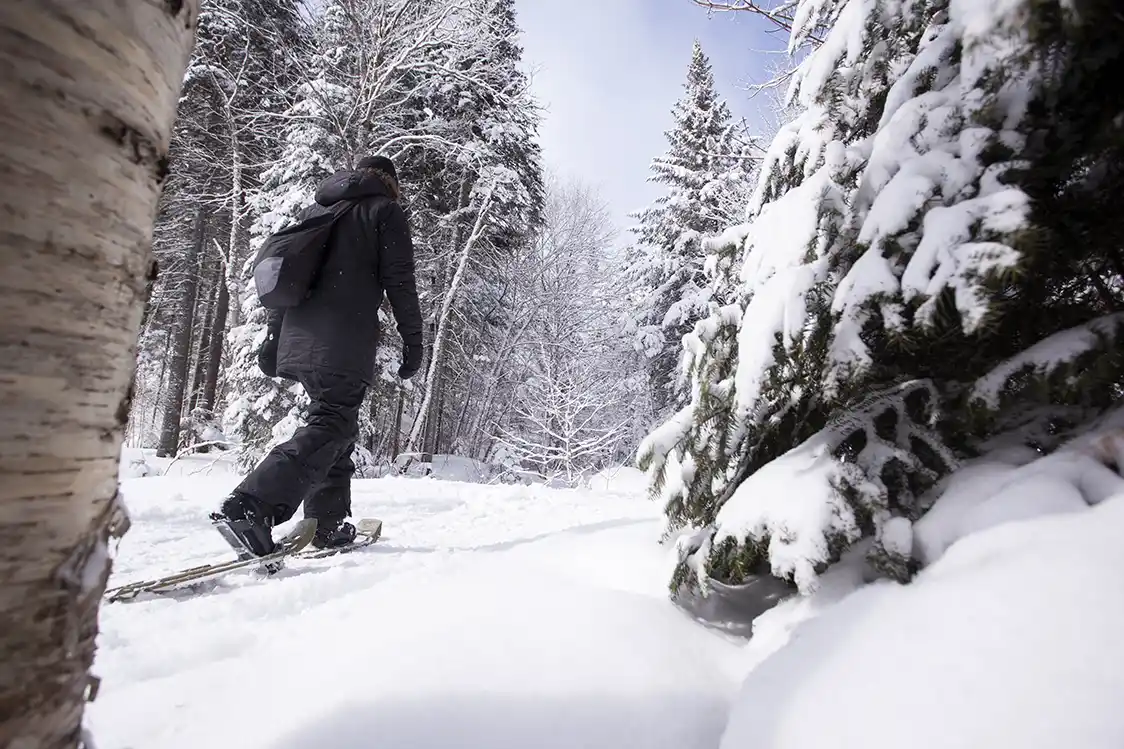
The fun doesn’t stop when the snow falls. Parc National du Mont-Mégantic is a year-round outdoor playground. Here are a few of the things you can get up to once the thermometer drops.
- Winter in Mont-Megantic NP: During the snowy season, the park transforms into a winter wonderland with trails open for snowshoeing, sledding, and cross-country skiing. Fat biking is also a popular activity on designated trails, offering a unique way to explore the snow-covered landscape.
- “From the Earth to the Stars”: The park is also home to the “From the Earth to the Stars” experience, a self-guided drive that features a scaled-down model of the solar system spread across 13 km of roads, allowing you to appreciate the vast scale of space. You can also explore the park’s two visitor centers for information, maps, and park souvenirs.
Access and Fees at Parc National Mont-Mégantic
Like all of Quebec’s provincial parks, there are access fees for entering the park and fees for both front-country and backcountry camping. These are all subject to change, so it’s best to check directly on their website here.
Best Time to Visit Parc National Mont-Mégantic
The best time to visit Parc National du Mont-Mégantic really comes down to what you want to get out of your visit. The park offers an amazing range of both benefits and challenges in every season, from the kaleidoscope of colors during autumn to the crisp, clear nights of winter.
Summer (Late June – Early September)
- Benefits: This is the peak season for travel to Mont-Megantic National Park for a reason. All services and facilities, including both campgrounds and the ASTROLab, are fully operational. The weather is warm and perfect for hiking, and the longer days allow for more time to explore the hiking trails.
- Challenges: It’s the busiest time of year to visit the park. Trails and campgrounds can get crowded, and you may need to book accommodations well in advance. It’s also important to note that this is a dark sky preserve, and summer has the shortest nights of the year. If you’re visiting for stargazing, you’ll only have a few hours of darkness to enjoy.
- Special Events: August is the best month to visit for the Perseid meteor shower, a major annual event that draws large crowds. The park and ASTROLab often host special evening programs and festivals during this period.
Fall (Mid-September – Late October)
- Benefits: This is arguably the most beautiful time to visit for nature lovers and hikers, and it’s my favorite time of year to visit Mont-Megantic NP. The surrounding landscape erupts in a stunning display of fall colors, offering breathtaking photographic opportunities. The weather is cooler and pleasant for hiking, and crowds begin to thin after the summer rush.
- Challenges: The weather can be unpredictable, with cooler temperatures and a higher chance of rain. Some services may operate on reduced hours as the season progresses.
- Avoiding Crowds: Visit on a weekday to enjoy the fall colors with fewer people. On the weekend, leaf peepers stream into the park to enjoy the autumn show.
Winter (December – March)
- Benefits: Winter at Parc National Mont-Mégantic offers a quiet, serene, and magical experience. The clear, cold nights are perfect for stargazing, as the air is less humid. The park is less crowded, and you can enjoy activities like snowshoeing, cross-country skiing, and fat biking on designated trails.
- Challenges: Some roads and facilities may be closed or have limited access. You must be prepared for extreme cold, and be sure to check trail conditions before you go.
- Best for Stargazing: The winter months often have the clearest skies, making them ideal for observing constellations and other celestial bodies.
Spring (April – Mid-June)
Challenges: It is often referred to as “mud season.” Trails can be wet and slippery from melting snow, and visitor centers and services operate on very limited schedules. Hiking can be difficult, and stargazing may be impacted by cloud cover.
Benefits: This is the quietest time to visit, making it perfect for avoiding crowds. As the snow melts and the park comes back to life, you can enjoy a sense of solitude on the trails.
You May Also Like To Read:

